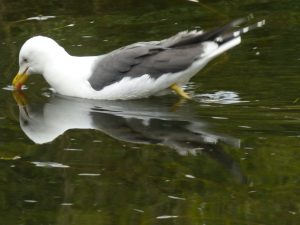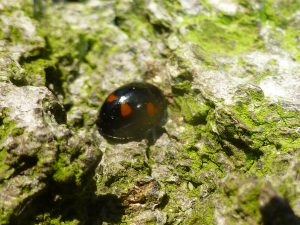March 2014 came in like a lamb but the ‘lion’ arrived around the first weekend with high winds that closed the Garden. It then warmed up a bit but the second half of the month was chilly, especially the last few days when there were easterly winds and it was very dreich with some mist and fog. This had an effect on the wildlife recorded.
Birds — Thirty-seven species of bird were recorded during March. There were no real unexpected surprises. A skein of Pink-footed Geese flew north on 5th, probably heading back to their Arctic breeding grounds. Black-headed Gulls visited almost daily until 19th but have not been seen since; they have also probably gone off to breed in the Pentlands or elsewhere. However, Lesser Black-backed Gulls (our only migrant gull species) were seen in the Garden from 12th onwards; they will be with us till around October. Redwing were last seen on 17th; they will no doubt have flown back to Scandinavia. The first Chiffchaff returned on 24th and began singing in the Chinese Hillside while a second one began singing near the Pond from 28th. Remarkably, Siskin were recorded on 21 out of 25 possible recording days bringing the year’s total records for that species so far to 53, only nine short of the 62 days when Siskin were recorded in the whole of last year! Great Spotted Woodpecker, Moorhen and Magpie were all seen nest-building and the Moorhen may now be incubating a clutch of eggs. The full list of bird species recorded during March was Blackbird, Blackcap, Black-headed Gull, Blue Tit, Bullfinch, Carrion Crow, Chaffinch, Chiffchaff, Coal Tit, Curlew, Dunnock, Feral Pigeon, Goldcrest, Great Spotted Woodpecker, Great Tit, Greenfinch, Grey Heron, Herring Gull, Jackdaw, Lesser Black-backed Gull, Long-tailed Tit, Magpie, Mallard, Mistle Thrush, Moorhen, Oystercatcher, Pink-footed Goose, Redwing, Robin, Siskin, Song Thrush, Stock Dove, Tawny Owl, Tree Creeper, Wood Pigeon, Wren.
Insects — Most of the insect activity was concentrated in the better weather in the first half of the month. The first butterflies were recorded on 11th when both Peacock and Small Tortoiseshell were recorded (the latter also on 12th); those were the only butterfly sightings. Bees were seen from 6th, when Honey Bee was first recorded for 2014. By the end of the month four species of bumblebee had been recorded: Buff-tailed (first record 10th, possibly as early as 25 February when an unidentified species was spotted), Early (12th), Garden (12th) and Common Carder (18th). Common Wasp was seen from 11th. Hoverflies were active in the sunshine between 3rd and 12th with five species recorded, with the dronefly species Eristalis tenax also being seen once later in the month (24th). Other flies included two bluebottle species and Common Cluster-fly which was a new garden record (12th, also 18th and 26th). The leafhopper Empoasca vitis was seen flitting amongst yew leaves from 12th onwards. The Orange Ladybirds continued to hibernate on a tree near the John Hope Gateway while Pine Ladybird was recorded twice (12th and 26th), neither of them on pine!
Other — Frog spawn was seen in the small ponds in the Scottish Heath Garden and Demonstration Garden areas. Fox and Badger betrayed their presence by droppings and grubbing activity on lawns, respectively.


